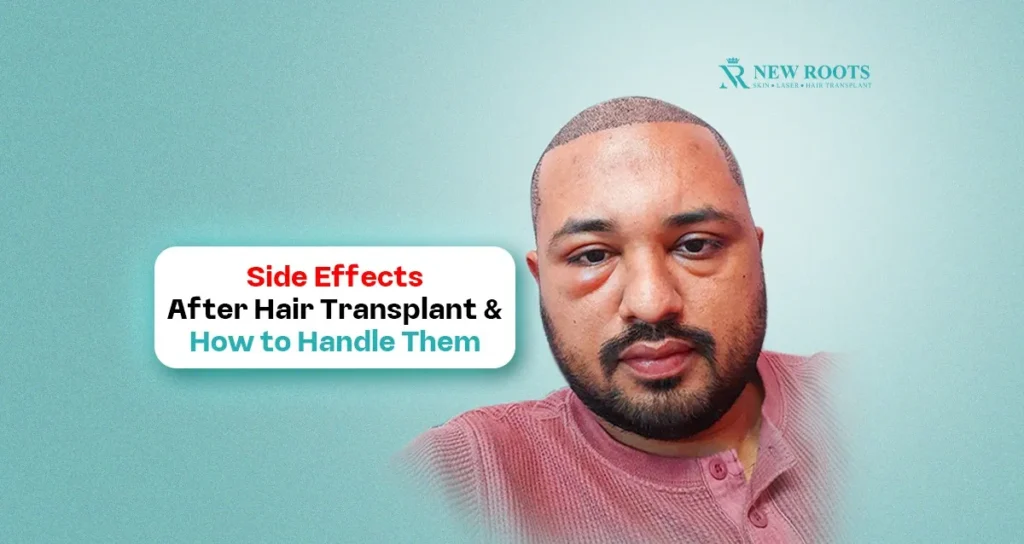It is therefore axiomatic that the appearance of side effects after hair transplant surgery is a cause for alarm to most patients. To ensure that a hair restoration process is a success, a client should be aware of such complications and their treatment, as well as the general prognosis of his or her hair.
This article will help you through the different concerns you may have concerning side effects after hair transplant as well as help you decide if it’s the right method for you to try.
Introduction
A hair transplant is a surgical operation to correct baldness with the help of shifting hair follicles from a donor area to a recipient location on the head.
The advantages patients consider offered by this technique include the ability to offer natural outcomes as well as being permanent.
But like any surgery, it is not without risk, and the most common is experienced as side effects after hair transplant surgery.
Table of Contents
Expected Adverse Effects of Hair Transplant
Some patients experience several side effects after hair transplant procedures, and most of them only last for several weeks. Knowledge of such effects facilitates the management of the process as well as the creation of the most comfortable environment possible during the recovery phase.

Swelling
Another frequent consequence of a hair transplant is swelling. Customers may experience redness of the skin in the scalp and forehead areas during the first days after the procedure. Local swelling is a common occurrence after the surgery and often resolves in one week, although patients may complain of discomfort.
Side Effect |
Duration |
Management |
|---|---|---|
| Swelling | Up to 1 week | Elevate head, apply cold compresses |
Itching
Some patients have reported itch as a perioperative side effects after hair transplant the itch starts around days 4–5 after the operation. As much as this is a normal healing process, one should refrain from scratching since this may eject newly implanted follicles.
Side Effect |
Duration |
Management |
|---|---|---|
|
Itching |
Up to 1 month
|
Use a mild shampoo, saline sprays
|

Bleeding
Bleeding may occur soon after the surgery, especially from the donor site. It is usually slight and should resolve when handled with great care; soaking can persist, but if this accompanies broken follicles, it should be communicated to the surgeon.
Side Effect |
Duration |
Management |
|---|---|---|
|
Bleeding |
Initial days
|
Gentle pressure and notify the surgeon
|
Pain and discomfort
Some patients may feel just a slight burning sensation as if they were grazed after the hair transplant surgery. Discomfort usually subsides after the first three days but may persist in some cases owing to the severity of the surgery.
Side Effect |
Duration |
Management |
|---|---|---|
|
Pain |
Up to 1 week
|
For over-the-counter pain relief, consult the surgeon
|
Graft Failure
Sometimes the grafts may not survive and hence the hair follicles may not implant into the area of the head it is intended to. This may be due to using the wrong method or inadequate blood circulation around the muscles.
Side Effect |
Duration |
Management |
|---|---|---|
|
Graft Failure
|
Poor implantation
|
Consult surgeon for further evaluation
|

Shock Loss
Shock loss is the process of premature loss of hair shafts transplanted which is generally/ding observed at 4-6 weeks post-surgery. Though quite alarming, it is a normal part of the growth cycle and usually passes when new hair starts to develop.
Side Effect |
Duration |
Management |
|---|---|---|
|
Shock Loss
|
Few weeks
|
Reassurance regarding regrowth
|
These Are Rare But More Dangerous:
Most of the side effects after a hair transplant are mild and may only manifest for a short period, but some need urgent attention from a healthcare provider. Knowledge of these relatively less frequent problems will therefore go a long way in early identification and management.

Infection
Infections are infrequent, but possible, and are noticed by increased pain, redness, or discharge. This risk is considerably minimized when a clean surgical environment is preserved.

Folliculitis
Folliculitis is a condition characterized by inflammation of hair follicles and may be seen in patients after surgery with pustules or bumps on the head. The main treatment is usually by the use of antibiotics.
Altered Sensation
Now and then, certain patients may have certain nerve irritation issues that lead to a feeling of numbness in the scalp. This is normally a temporary phenomenon and consequently should be mildly supervised.
Scarring in Hair Transplants
It is a usual event that happens after surgery and the extent depends on the approaches that were applied FUE and FUT. Some pigmentation may also be apparent, but mild to no scarring can in general be anticipated, while few cases of keloid scarring are possible- these are usually knotted and prominent.
Recovery Time and Aftercare
People can take several months before they can get healed and see hair development after a hair transplant surgery. The following aftercare should therefore be recommended to reduce the risks of complication and enhance outcome.
Post-surgery Hair Care Techniques
Hair care measures after hair transplant surgery are important to promote scalp healing, graft viability, and productive hair shaft development. Here are seven essential points to consider:
Gentle Hair Washing
After surgery, the patient should wash the operated area with mild sulfate-free shampoo. Bathing should start after five days of the surgery and should be a mild process in order not to irritate the grafts by rubbing on the skin.
Since hair therapy takes some time, at least sometimes weeks, the use of heat-style tools such as the blower dryer, curling iron, or flat iron should not be used. It should also not be used to protect the sensitive scalp, as scrupulous products contain very strong chemicals or very heavy prescriptive agents.
Limit Physical Activities
There should be not and physical and extreme work in which something comes that may cause problems in your head like inching so as the Doctor recommended It should not be taken for at least ten days following the transplant, said the specialists.
Keep the Scalp Moisturized.
A moisturizing lotion or certain treatments for post-transplant patients can be used to make the scalp less sensitive in the process of healing. Moisturization of the scalp is essential in the healing procedure that should take place after an ailment.
Wear a Loose Hat or Scarf.
The scalp should not be exposed directly to the sun, especially during the first one to two weeks of the process. Some loose fittings, such as hats or scarves, may be worn on the head to protect the area while at the same time allowing for air circulation, which is very important if the wound is to heal.
Read through the Dos and Don'ts.
Staying strictly to the postoperative instructions given by your surgeon is of paramount importance. This involves strictly following the doctor's prescription, refraining from certain tasks, and attending repeat appointments to check on the progress of healing.
Post-Operative Instructions
Patients should adhere strictly to their surgeon’s advised regimes to prevent scenarios such as immense bleeding or infection. Patients should be advised to:
Avoid Heavy Exercise:
Exercises for lifting heavy objects and any other strenuous activity should be done at least 2 weeks after undergoing surgery.
Maintain Scalp Hygiene:
Conjunctive or gentle washing of the scalp can begin from the fifth day and onwards.
Keep Head Elevated:
This may help decrease inflammation, especially in the first two days.
Post-Op Care Instruction |
Duration |
|---|---|
|
Avoid vigorous activities
|
2 weeks post-surgery
|
|
Start gentle washing
|
From day 5 onward
|
|
Sleep elevated
|
First-week post-surgery
|
This is very important; do not scratch it; be patient.
However, some discomfort is normal, and patients may develop a development of hair that is visible only after several months, so patience is needed, especially during the initial healing phase. And when they scratch, they may dislodge the graft and/or get infected. The development of the hair is visible only after several months, so patience is needed, especially during the initial healing phase.
Consulting a Healthcare Professional
It is advisable to always consult a doctor soon after experiencing any adverse effects of a hair transplant. Whether you’re feeling anxious, it’s always recommended to consult your surgeon if you wish to know the best move to make.
Optimizing Healing: Post-Transplant Medications Explained by Dr. Swati Aggarwal
Dr. Swati Aggarwal on how prescriptions are important before hair transplant surgery. She divides the medications into three sections, which are intended for immediate, transplant surgery, and growth phases, stressing the value of a customized diet for patients who may require different times to recover.
Key Points
Post-operation medications are drugs given to the patient in the first few hours or days following transplantation.
The first few seconds of the video begin with an explanation of the importance of the usage of post-transplant drugs in hair transplants.
Drugs are prescribed in the first 5-7 days to treat overaggressive inflammation, pain, and irritation after organ surgery.
This is usually treated using analgesics like paracetamol and/or non-steroidal anti-inflammatory agents like Ibuprofen and antibiotics including Amoxicillin to reduce the incidence of infection.
For complications such as hyperacidity arising from the medications, patients receive a proton pump inhibitor, which is Pantoprazole.
Sustaining Transplantation
In the long run, drugs are adjusted to maintain the graft, which may be from three to six months after the transplant.
Other important drugs include dutasteride and finasteride for hair conservation and regrowth after hair transplant surgery.
Furthermore, topical preparations such as minoxidil are started three weeks after the operation, and it is used for the promotion of hair growth and providing support to hair shafts.
In addition to these, most patients are treated with multivitamins, biotin, iron, and omega products for general body improvement.
Long-Term Comparative Analysis and Amalgamation
More often, no other medications may be needed six months after the transplant if the donor area is once again healthy and sufficiently thick.
Even in younger patients or those with thin donor areas, finasteride must be continued uninterruptedly, which again reinforces the point for individualized medical regimens.
Lastly, the video targets the psychological side of past pill-taking and reminds viewers to talk to their doctor.
This brief article captures the most important information concerning the administration of medications after hair transplant surgery, as stated by Dr. Aggarwal. Every segment underscores the appropriateness of client-specific and recovery phase-specific strategies.
Choosing a Reputable Surgeon
To reduce the complication rates, it is recommended to choose a good hair transplant surgeon and the clinic. It’s important to:

Research credentials:
Make sure they have formal certification and have dealt with hair transplant surgery for a considerable time.
Read reviews:
The narratives of patient experiences may shed light on the effectiveness and patients’ treatment experience.
Conclusion
Managing side effects after a hair transplant is one of the vital things that a patient has to face while taking their hair back. Although many side effects are short-term and can be treated, knowledge assists patients in seeking appropriate interventions to get the best results.
It means that the patients should pay proper attention to aftercare and remember to consult with the doctors; meanwhile, they should also make efforts to choose the right hair transplant surgeons to ensure higher success rates for hair transplant surgery.
Always embrace good health as you begin this process, and remember to always seek advice from your hair doctor when necessary.




